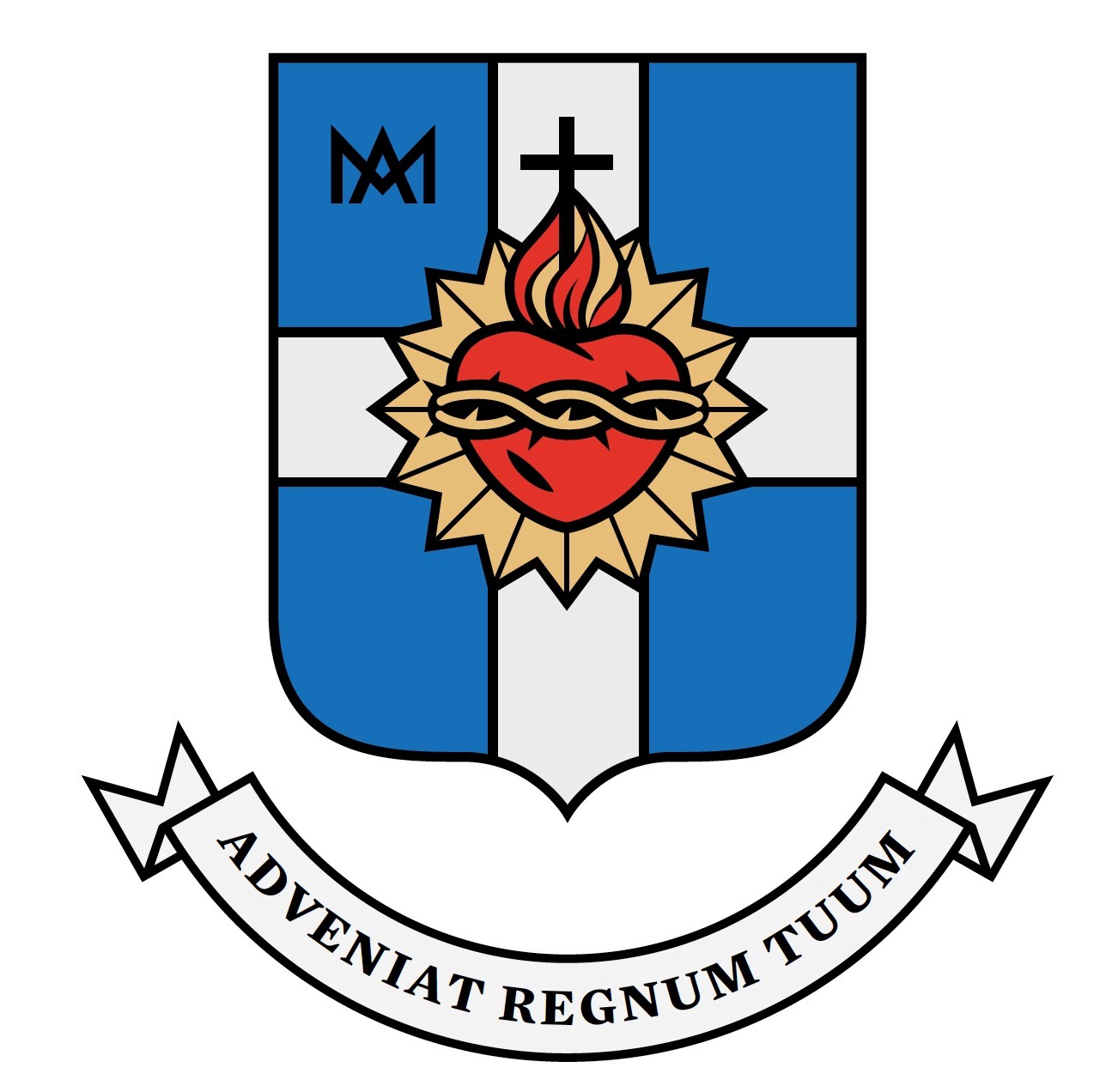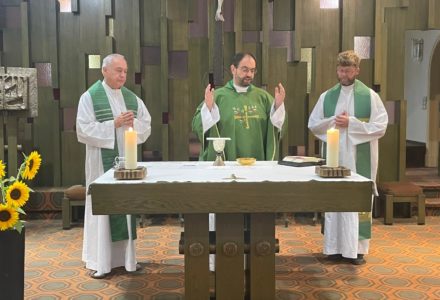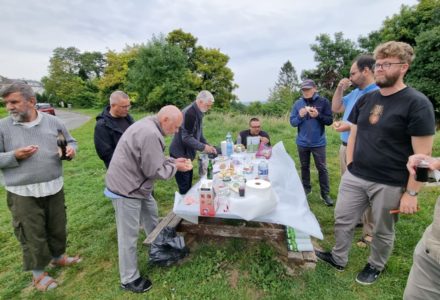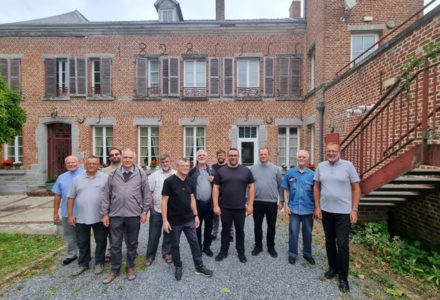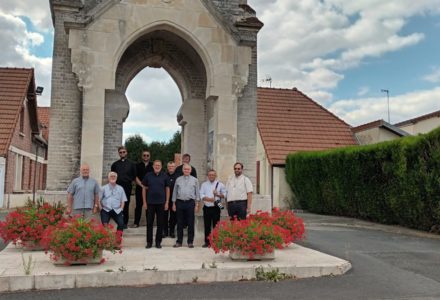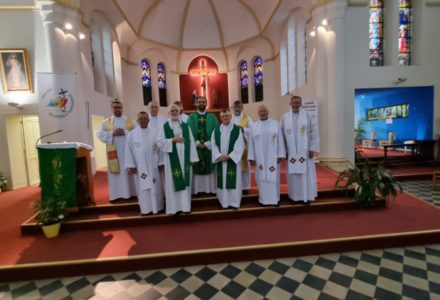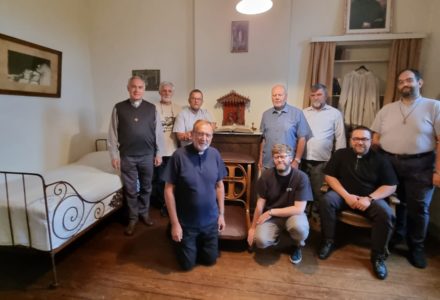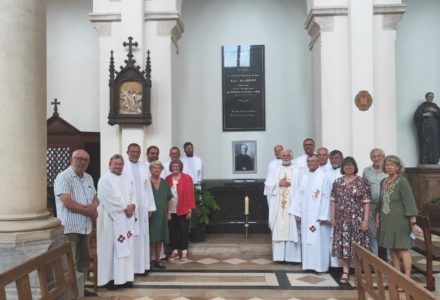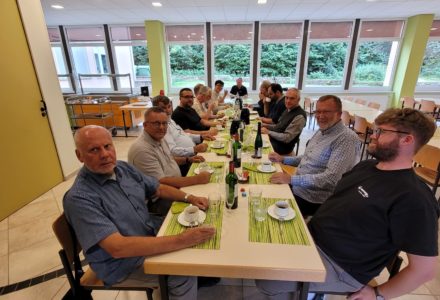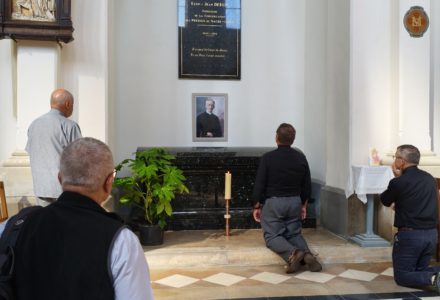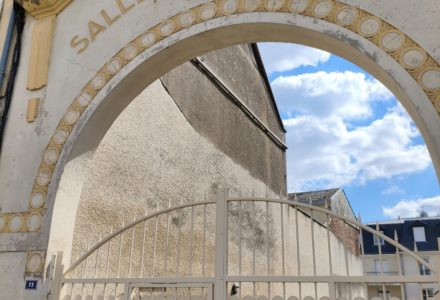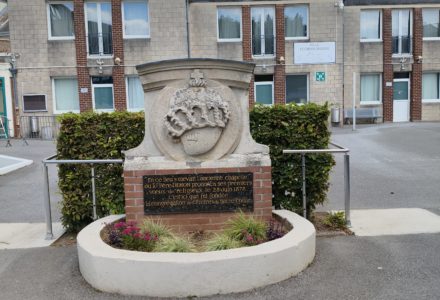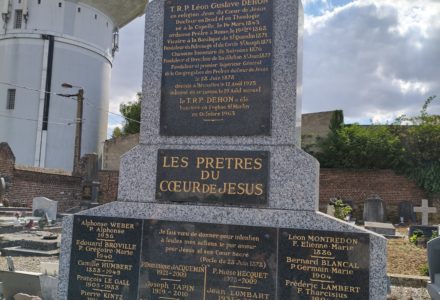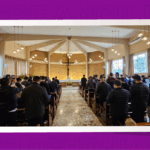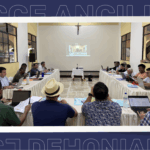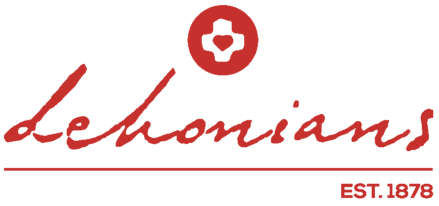On the occasion of the centenary of Fr. Dehon’s death, a delegation of Polish Dehonians made a pilgrimage to the key places of Fr. Dehon’s life.
Summary
For about 25 years, candidates for perpetual vows of the Priests of the Sacred Heart in Poland have undertaken a pilgrimage to sites associated with the life of the founder, Father Léon Jan Dehon. On the occasion of the centenary of his death, a delegation of Polish priests embarked on this pilgrimage, combining spiritual reflection with historical and liturgical visits.
The journey began in Stadnik, Poland, and passed through several locations in France and Belgium, notably:
- Freiburg, to meditate on the Dehonian invocation Ecce venio;
- Cluny and Ars-sur-Formans, to explore Christian history and the sanctuary of Saint John Vianney;
- Paray-le-Monial, the site of the Sacred Heart revelations to Saint Margaret Mary Alacoque, and the Hieron museum;
- Paris, including Notre-Dame Cathedral, Saint-Sulpice Church, the Basilica of the Sacred Heart, and places linked to the founder’s childhood and studies;
- Soissons, Laon, and Liesse-Notre-Dame, to contemplate the love of the Heart of God and Father Dehon’s social works;
- Saint-Quentin, the founding site of the congregation and its educational and social mission;
- Ixelles (Brussels), where Father Dehon died, and Clairefontaine and Luxembourg, to visit the congregation’s first houses.
Each day combined Mass, adoration, meditation on the Dehonian charism, and cultural or historical exploration. The pilgrimage concluded in Stadnik, Poland, leaving participants with a profound spiritual experience and a deepened understanding of the Dehonian identity.
______________________
For about 25 years, there has been a custom in our Province whereby candidates for perpetual vows go on a pilgrimage to places associated with the life and vocation of the Founder of the Congregation of the Priests of the Sacred Heart. This journey to the sources of history that shape the identity of the spiritual sons of Father Leon Jan Dehon is always an opportunity to ask what it really means to be a Priest of the Sacred Heart of Jesus. On the 100th anniversary of the Founder’s death, the Province in the persons of Fr. Witold Januś, Provincial Vicar, Fr. Marek Romańczyk, Provincial Treasurer, Fr. Wiesław Święch, Fr. Dariusz Salamon, Rector of the Seminary, Fr. Tadeusz Wołos, Fr. Marek Przybyś, Fr. Andrzej Gruszka, and Fr. Stanisław Zawiłowicz decided to take up this challenge. Fr. Grzegorz Siedlarz, provincial secretary, was responsible for the logistics of the pilgrimage, i.e. the route, provisions, and accommodation, while Fr. Jakub Bieszczad from Rome was responsible for the spiritual, translational, and sightseeing aspects.
As usual, the pilgrimage set off from Stadnik after Mass celebrated by Fr Grzegorz at 5 a.m. on 16 August. The first day, spent in meditation on the Dehonian invocation Ecce venio, was devoted to covering over a thousand kilometres and reaching the French border. Accommodation was provided at our student residence in Freiburg im Breisgau, where the convoy arrived at around 8:00 p.m. Fr. Jakub had been waiting for the group at the Freiburg monastery for several days, and Fr. Stanisław also arrived shortly before the pilgrims; both had participated in the seminar of the European Dehonian Theological Commission in Clairefontaine on the occasion of the centenary of the Founder’s death.
The second day, devoted to meditation on Oblation and Reparatory Adoration, began with Holy Mass celebrated at 7:15 a.m. by Fr. Jakub. After breakfast, there was time to visit the Freiburg Cathedral, said to have the most beautiful tower in the world. The long distance forced the pilgrims to set off immediately on their journey towards Lyon, France. After several hours of driving, at around 3:00 p.m., the group stopped in Cluny to visit the famous medieval monastery, a unique witness to history. The last stop of the day was a visit to Ars-sur-Formans, the sanctuary of St. John Vianney. Here, too, the pilgrims spent the night with the Workers Missionary Sisters of the Immaculate.
On the third day, the pilgrimage set off for Paray-le-Monial, a place associated with the revelations of the Sacred Heart of Jesus to St. Margaret Mary Alacoque. The theme of the day was the Reparation. The visit to this unique place began with Adoration in the chapel of St. John, followed by an opportunity to visit the Basilica of the former Cluniac monastery and its remains. At 12 noon, the pilgrims arrived at the Chapel of the Revelations, where Fr. Witold celebrated Holy Mass. After lunch, they visited the chapel and tomb of St. Claude de La Colombière, followed by a tour of the Hieron, a museum of Christian art established during the lifetime of Fr. Dehon as an expression of a new approach to evangelisation, in which everything can speak of God. In the evening, the group arrived in Arcueil, near Paris, where they stayed in a dormitory run by the Pallottines.
Fr. Wiesław presided over Holy Mass, which began the fourth day of the pilgrimage, dedicated to reflection on our charism, handed down to us by our Founder. The day was exceptionally rich in sightseeing, as it was an attempt to see the most important sights of Paris in about 12 hours. A fast train RER took the group to the renovated Notre-Dame Cathedral, which they were able to enter almost immediately. The renovated walls delighted with their beauty, cleanliness and the desire to preserve what has not changed since 1163, when its construction began. After leaving the cathedral, the tour route led towards the Sorbonne buildings, where the young Leon Dehon learned the secrets of civil law. Walking towards the Church of St. Sulpice, the parish of the Founder from his student days and his Parisian centre of spirituality, we managed to see the Pantheon building and the Luxembourg Gardens. In the church of the former abbey of Saint-Germain-des-Prés, the group prayed at the tomb (containing only the heart) of Polish King John II Casimir, who was the commendatory abbot there after his abdication and arrival in France. Before lunch, we also visited the Shrine of the Miraculous Medal with the tombs of St. Louise de Marillac and St. Catherine Labouré. A short visit to the Trocadéro square offered a beautiful view of the Eiffel Tower, followed by a walk along the Champs-Élysées between the Arc de Triomphe and the Place de la Concorde, allowing us to experience one of the most recognisable parts of Paris. The day ended with Adoration in the Basilica of the Sacred Heart on the Parisian hill of martyrs (Montmartre), a place that was built ‘in front of’ of the Founder and in whose consecration he was to participate.
The fifth day, dedicated to contemplating the Love of God’s Heart, began with Holy Mass presided over by Fr. Dariusz. After breakfast, the convoy headed north of Paris to Soissons, where the participants admired the Cathedral of Sts. Gervasius and Protasius, as well as the Monastery of St. Medard from the Merovingian period, the site of a school for deaf children where the Dehonians worked at the end of the 19th century. In Laon, where Fr. Dehon was holding Ignatian retreats, the group visited the Cathedral of Our Lady. Finally, in Liesse-Notre-Dame, the royal sanctuary to which Dehon made pilgrimages with his mother and where he organised social gatherings, the pilgrims held Adoration. In the evening, the convoy arrived in La Capelle, where for a quarter of a century, in the Founder’s family home, a Dehonian community, including three Poles, has been living and working. They also managed to see the hippodrome, which was started by the Founder’s father, and the monument commemorating the armistice of 7 November 1918, which was officially ‘trumped’ in La Capelle.
The sixth day was a visit to the place where it all began, in Saint-Quentin, where Fr. Dehon became the seventh vicar, zealously undertaking his mission, where he founded the Congregation of the Oblates and Priests of the Sacred Heart at St. John’s College, where he experienced the drama of the occupation and where he was buried. The life and work of the Founder was the theme of the sixth day. After praying at the tomb, Fr. Marek P. presided over Holy Mass in St. Martin’s Church with a group of lay people from the Dehonian community, gathered by the parish priest, Fr. Stanisław Wawro. They welcomed the pilgrims for lunch, after which the group followed in Dehon’s footsteps (the gate of St. Joseph’s works, the chapel of St. John’s College, the basilica and main square, the cemetery with the graves of the confreres and Servants of the Sacred Heart, and the remains of the Apostolic School in Fayet). On the way back, the group stopped in Guise, a factory that implemented a socialist utopian vision of a self-sufficient community. After dinner, we also managed to see the parish church of St. Grimonia, designed by the architect of the Paris Opera, L. Garnier, and the chapel at the site of the martyrdom of the town’s patron saint, from whom the settlement takes its name and originates in the early Middle Ages.
After Holy Mass celebrated by Fr. Marek R. in the chapel of the house in La Capelle, the seventh day of the pilgrimage began, dedicated to contemplating the death of the Founder. The house in Ixelles, Brussels, where Fr. Dehon died, was the destination of the pilgrimage on that day. Just being close to the place where the Founder spoke his last words and breathed his last breath was a unique experience, but the group also took the opportunity to visit the city under the guidance of Fr. Paweł Słowik from the community. They managed to see the royal palace, the Cathedral of St. Michael and St. Gudula, the Central Square, the famous Manneken Pis fountain and the Church of Our Lady of Victory in Sablon.
The eighth day began with Holy Mass in the chapel of the Brussels house, celebrated by Fr. Jakub, on the 100th anniversary of the death of the Father Founder. The day was devoted to the history of the first fathers, especially those who knew Fr. Dehon, and whom the pilgrims had the opportunity to meet, particularly Fr. Władysław Majka, a witness to his death a century ago. After breakfast, the group went to the oldest house that has continuously belonged to the Congregation since 1889, located in Clairefontaine. Fr. Nico Turmes, provincial bursar of the EUF, showed the pilgrims around the former school of the Congregation for Luxembourgers, which now houses a spiritual and conference centre. After lunch, the convoy went to Luxembourg, where they visited the tomb of Fr. Dehon’s first successor, Bishop Joseph Philippe, in the cathedral. From the airport in Luxembourg, Fr. Jakub travelled to Rome, while the nine pilgrims went to the house of German province in Maria Martental near Cochem in the diocese of Trier. Adoration celebrated in the local sanctuary church finished the day.
On the last day of the pilgrimage, Fr. Andrzej Gruszka presided over Holy Mass at 6:00 a.m. At around 8:00 a.m., the return journey through Germany and Poland began. At around 8:00 p.m., the convoy arrived in Stadnik, full of gratitude for God’s Providence along the way, for those involved in preparing and leading the trip, for benefactors, and for all those who accompanied them spiritually on the journey. The experience gained and brought back will be an opportunity to continue reflecting on the Dehonian identity and the necessary renewal of the Love that Fr. Dehon lived in his time and which he asked his followers to live.

